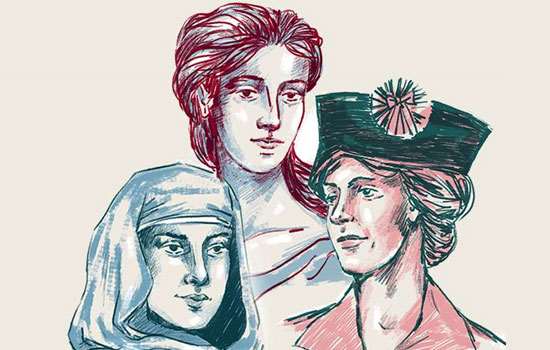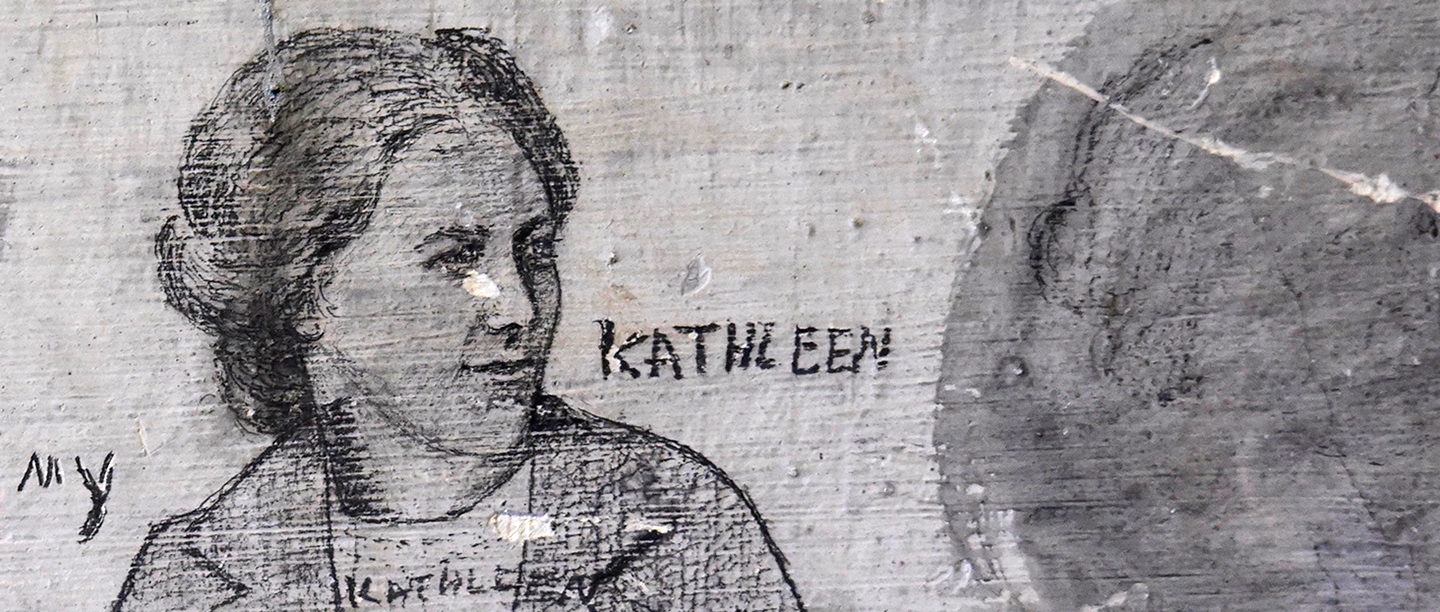Staying true
Annie Wainwright was born in 1897 in Conisbrough, South Yorkshire, the second of five children to colliery winder William and his wife, also named Annie. The Wainwright family were part of a strong local Methodist community. Early in the First World War, Annie became engaged to Bert Brocklesby, a teacher, preacher, organist, choir master and, from May 1916, conscientious objector.
Bert was served his enlistment papers shortly after conscription was introduced, but applied for exemption on the grounds of his conscience. His conviction that ‘thou shalt not kill’ led him from a local tribunal at Pontefract to the Richmond cell block, to court martial in France, to hard labour outside Aberdeen and to long periods of solitary confinement in civilian prisons across the country. It was while detained at Richmond for refusing to carry out military orders that Bert recorded at least five graffiti on his cell walls, including the likeness of Annie.
Annie remained loyal to Bert throughout his ordeal. It was a stance that would have brought her significant challenges. Conscientious objectors were vilified in the popular mind: seen as cowards and shirkers, they were represented as un-Christian and unpatriotic, and their family and friends risked being ostracised within their own community.
It is possible Annie’s experience may have been eased by a tolerance within the Methodist community and the fact that her own brother and two of Bert’s had chosen to fight. The Wainwright and Brocklesby families remained close to each other and respected within Conisbrough.
Breaking free
Annie had been able to visit Bert in prison just once. Bert, who was eventually released in April 1919, announced that he would travel to aid orphaned children in Berlin or Vienna – in what was then enemy territory. Annie, whose brother was killed in action, found she could no longer support him, and broke off their engagement.
A year later she married Walter Marsdin, three years her senior, and who had seen four years’ service on the western front. They shared a long marriage (57 years) but not a conventional one, living long periods apart and moving in their own social circles.
Bank manager Walter is said to have lived the high life, inviting music hall artists home after a show to sing or play piano. Annie had close friendships with a number of women and together they travelled throughout Europe between the wars. In 1936 she found herself in Spain as the civil war erupted and had to be evacuated on HMS Repulse. For her this was an exciting time. Her uncle, on the other hand, summed up what was perhaps the family view: ‘Silly little madam; she’ll get herself killed.’
In photographs from that period, Annie stares out confident and challenging. One family anecdote recalls Annie and a friend arriving at a fashionable evening in a stately home and finding the other guests had followed a different dress code. Her friend was uncertain: what were they to do? ‘We shall go in,’ Annie replied firmly. ‘It is the others who have got it wrong.’
Settling down
After the Second World War, Annie moved to Devon with a friend to run a café in Shaldon. Walter remained in Barnsley, South Yorkshire. Annie then bought Burlington House in Teignmouth, near Shaldon, living in the ground-floor rooms and renting out the other floors as flats.
Her nephew William Wainwright recalls one episode involving the theft of Annie’s swimsuit from the garden. Aunty Nan (as he called her) and friends were concerned about what to tell the policeman called to investigate, as none of them thought it decent to admit that a 60-year-old woman still sported a swimsuit. The problem was apparently resolved when Annie told him she was 45 (the policeman had allegedly already written down 40).
Annie moved back to South Yorkshire in the late 1950s, then she and Walter sold up and took a flat back in Devon, overlooking the harbour in Torquay. Together they took their place in society, she playing bridge at the Royal Torquay Yacht Club and he as president of the Conservative Club. Walter died in 1977 at the club, where, according to family lore, he was careful to put down his lunchtime pint before collapsing from a heart attack.
Annie then moved to be with a niece in Drymen, Scotland, where she died, having succumbed to dementia, in July 1982.
Annie, remembered
The portrait in the Richmond Castle cell block is of an Edwardian lady – a woman who, as part of an earnest and close-knit community, was fondly remembered by Bert Brocklesby.
Yet after the war she seems to have broken free from convention and expectation – from the role determined for her by the town and the social group that she grew up in. Did her wartime experience change Annie and alter her outlook, or did it bring a nascent character to the fore?
We cannot know, but as her nephew William remembers her:
The Annie that I knew was a modern – for her period – emancipated woman, independent, intelligent, who did not suffer fools gladly.
Whether she was escaping from a previous life I cannot say, because I knew absolutely nothing about her romance with Bert. But she was certainly keen to live a more interesting life, to move far and do more interesting things than the great mass of people. She certainly broke away from Conisborough and travelled far.
Sources
- William Wainwright, Annie’s nephew: written notes, correspondence and images
- Denise Blair, whose mother was Annie’s first cousin: correspondence, images and family tree
- Ellsworth-Jones, W, We Will Not Fight: The Untold Story of World War One’s Conscientious Objectors (London, 2008), 270–271
Find out more
-

Women in history
Read about women, both famous and overlooked, who have shaped England.
-

The cell block graffiti
Learn more about the graffiti made by prisoners at Richmond Castle and browse the online gallery.
-

Speaking With Shadows podcast
Listen to an episode on the conscientious objectors held at Richmond Castle.
-

Visit Richmond Castle
See the exhibition on the conscientious objectors and take in the views of the Yorkshire Dales.
